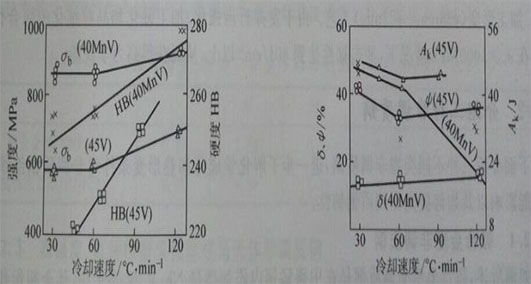After non-quenched and tempered steel is forged and heated using a medium frequency induction forging heating furnace, the post-forging cooling rate has a significant impact on the strength and toughness of the non-quenched and tempered steel, and determines the final process and performance of the parts. Generally, the strength and hardness of microalloyed non-quenched and tempered steels increase with increasing cooling rate after forging. The main reason is that as the cooling rate increases after forging, the number of pearlite in the steel structure increases and the spacing between pearlite sheets decreases.
The cooling rate of non-quenched and tempered steel after forging, especially the cooling rate between 800°C and 500°C, will significantly affect the grain size of the steel, the quantity and shape of ferrite and pearlite, the interlamellar spacing and pearlite of pearlite The thickness of cementite sheets in the body, as well as the number and particle size of microalloyed carbon and nitrides in the steel, thus affect the mechanical properties of non-quenched and tempered steel. Under normal circumstances, non-quenched and tempered steel forgings can be stacked and cooled below 500°C.
When the cooling rate of non-quenched and tempered steel increases after forging, its strength and hardness increase, while the plasticity and toughness have three situations depending on the cooling rate: the plasticity and toughness increase, change little, and decrease. The effects of post-forging cooling rate on the strength, hardness, plasticity and toughness of F40MnV and F45V steel are shown in the left and right curves of the figure below. as illustrated:

(1) For F40MnV steel, as the cooling rate increases, the strength and hardness of F40MnV steel increase. While the plasticity decreases slightly, the toughness decreases significantly, especially when the cooling rate is greater than 65°C/min. As the cooling rate increases, the toughness decreases more.
(2) For F45V steel, as the cooling rate increases, the strength and hardness of F45V steel increase. The change in toughness is not great. Once there is a cooling rate with lower toughness (65°C/min), cooling is accelerated above this speed. For example, when the cooling rate is increased to 90°C/min, the toughness of F45V steel will be improved.
Generally, the cooling rate after forging should not exceed 150°C/min to prevent the formation of bainite structure that affects toughness and cutting performance.
Based on the above factors that affect the mechanical properties of non-quenched and tempered steel, it can be seen that for different non-quenched and tempered steels, the forging heating temperature, final forging temperature, deformation amount and forging temperature of the steel parts in the medium-frequency induction forging instantaneous furnace can be changed according to their chemical composition. Post-cooling rate adjusts the mechanical properties of steel. The adjustment of the cooling rate after forging must be coordinated with other process parameters to achieve better results.




 en
en  cn
cn  jp
jp  ko
ko  de
de  es
es  it
it  ru
ru  pt
pt  vi
vi  th
th  pl
pl 








 GS-ZP-1200
GS-ZP-1200


